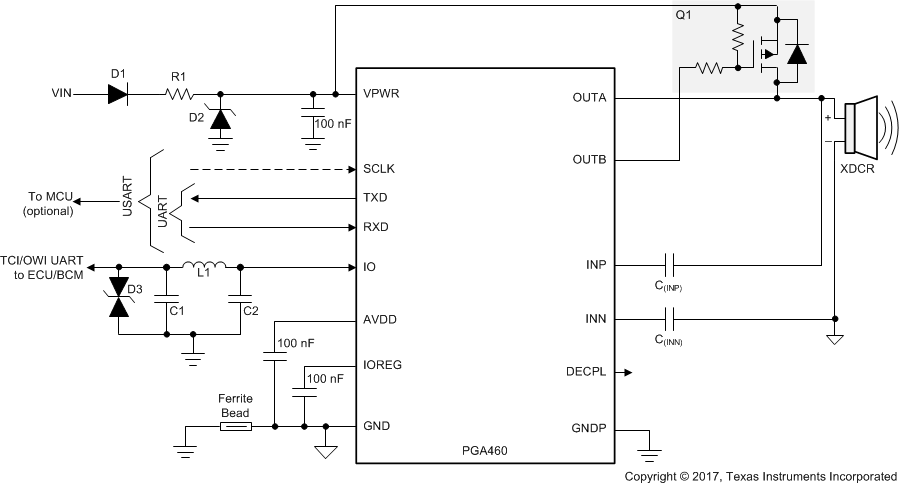SLASEJ4C April 2017 – February 2023 PGA460
PRODUCTION DATA
- 1 Features
- 2 Applications
- 3 Description
- 4 Revision History
- 5 Pin Configuration and Functions
-
6 Specifications
- 6.1 Absolute Maximum Ratings
- 6.2 ESD Ratings
- 6.3 Recommended Operating Conditions
- 6.4 Thermal Information
- 6.5 Internal Supply Regulators Characteristics
- 6.6 Transducer Driver Characteristics
- 6.7 Transducer Receiver Characteristics
- 6.8 Analog to Digital Converter Characteristics
- 6.9 Digital Signal Processing Characteristics
- 6.10 Temperature Sensor Characteristics
- 6.11 High-Voltage I/O Characteristics
- 6.12 Digital I/O Characteristics
- 6.13 EEPROM Characteristics
- 6.14 Timing Requirements
- 6.15 Switching Characteristics
- 6.16 Typical Characteristics
-
7 Detailed Description
- 7.1 Overview
- 7.2 Functional Block Diagram
- 7.3
Feature Description
- 7.3.1 Power-Supply Block
- 7.3.2 Burst Generation
- 7.3.3 Analog Front-End
- 7.3.4 Digital Signal Processing
- 7.3.5 System Diagnostics
- 7.3.6
Interface Description
- 7.3.6.1 Time-Command Interface
- 7.3.6.2
USART Interface
- 7.3.6.2.1 USART Asynchronous Mode
- 7.3.6.2.2 One-Wire UART Interface
- 7.3.6.2.3 Ultrasonic Object Detection Through UART Operations
- 7.3.6.3 In-System IO-Pin Interface Selection
- 7.3.7 Echo Data Dump
- 7.3.8 Low-Power Mode
- 7.3.9 Transducer Time and Temperature Decoupling
- 7.3.10 Memory CRC Calculation
- 7.3.11 Temperature Sensor and Temperature Data-Path
- 7.3.12 TEST Pin Functionality
- 7.4 Device Functional Modes
- 7.5 Programming
- 7.6 Register Maps
- 8 Application and Implementation
- 9 Device and Documentation Support
- 10Mechanical, Packaging, and Orderable Information
Package Options
Mechanical Data (Package|Pins)
- PW|16
Thermal pad, mechanical data (Package|Pins)
Orderable Information
8.2.2 Direct-Driven (Transformer-Less) Method
The direct-driven method substitutes the traditional center-tap transformer with a bridge driver, and is suitable for plastic-shelled open-top transducers. Any open or closed top transducer can be driven directly, but the maximum amount of SPL may not be generated during transmission. The direct-driven configuration uses either a half-bridge or full-bridge gate driver to generate an alternating square wave to drive the transducer. By default, the half-bridge driver configuration is enabled to allow the use of a single transducer to transmit and receive. The PGA460 device cannot drive a single transducer in the full-bridge configuration without the addition of external components (beyond the scope of this document).. Because the low-side drivers are integrated into the PGA460 device, only one external high-side p-channel MOSFET is required. In the half-bridge configuration, one OUTx channel is used to drive the p-channel MOSFET, while the other is used to directly excite the transducer.. #X9986 shows the direct-driven method schematic for a single transducer.
 Figure 8-6 Direct-Driven Method Schematic
Figure 8-6 Direct-Driven Method Schematic